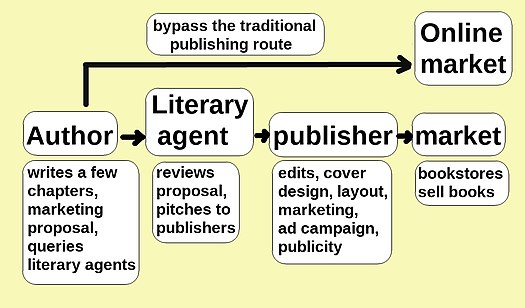Self-publishing is the publication of content by its author without the involvement of an established publisher. The term usually refers to written media, such as books and magazines, either as an eBook or as a physical copy using Print on Demand [1] technology. It may also apply to albums, pamphlets, brochures, video content, and magazines.
In the traditional publishing model, in which the publisher bears all the costs and risks of publication, but retains most of the profit if the book is successful. In self-publishing, the author bears all the costs and risks, but earns a higher share of the profit per sale.
The quality of self-published works varies considerably, because there are no barriers to publication and no quality control.
Everyone has written sometime in is life, a note, email, message or an essay or story. The crux of self-publishing is a bid to become a celebrity by honest means. This quality may appear a great motivator for yourself, but it might be just a riffraff for an established publisher. Writing takes work, and even when you’ve poured your sweat, blood, and tears into a project, there is no guarantee your project will move beyond your circle of connections.
Here are bits of my experience in this arena.
Traditional publishing, Vanity publishing, and Self-publishing are the names given to the processes of publication, and Vanity is the sarcastic way they refer to you as a self-publisher. So, if you find nothing concrete in this article here, you may still find something of value that could confront you in your life as an author, sooner than later.
Comprising costs
Self-publishing is a technique of publishing proposed to be operating without the props of the external editors, literary agents or a publisher’s distribution network. So, they say. But be aware this is just wishful thinking. You may be constrained and forced the help of external props or mafia, and end up spending about Rs 1 Lakh and more, or USD 1000 in putting your book in the readers chair. So, if you are not a celebrity or you don’t have a godfather, you may have to go via this self-publishing route.
Steps to publication
- Idea and concept
- Writing
- Rewriting
- Story editing
- More rewriting
- Copy-editing
- Layout and typesetting
- Cover design
- Purchase an ISBN
- Select platform(s)
- Choose price
- Choose distribution channel(s)
- Upload
- Marketing and promotion
- Shipment to end user or reader
The resulting commissions may trickle your way painfully slowly. Your actions start after you have completed your manuscript and then it is a long way to being a celebrity …
First – the self-editing
If you haven’t read your manuscript at least ten times, you have not even started the manuscript. Better do it now. And this effort doesn’t imply reading to find out spelling or grammar mistakes, but for the overall structure and the pace of your story. Spelling checks or grammar checks can be easily delegated to the available software for the same.
Preparing and selling a manuscript
Now you have to reach out to a publisher. And most renowned publishers, I would not call them decent or upright publishers, ask you to submit your manuscript through a literary agent. And you know what, the literary agents are more difficult to find than the publishers. If you can somehow lay your hands on an agent or a service like the Literary Market Place, the first thing they all want is you to become a member of their group. And that is a heavy cost from Indian standards.
Be aware that the addresses for publishers and literary agents that you find on the internet are only notional. The real addresses of publishers are given to only the literary agents. I don’t know how the literary agents get nominated but I know for sure that if anyone is nominated, he or she should have dealt with at least one successful book. So, do you sense the first echelon of mafia in this game?
There are make shift local editors who promise you to put your book in the hands of a literary agent. And if you are hooked on, all it means at least two months or more in the process, and certainly about Rs 15,000 per manuscript.
Let us say you are able to convince a literary agent that your manuscript is the best in the world for your genre, yet he or she needs a lot of money to get hired. So, you end up paying something like Rs 25,000 for hiring a literary agent who gives no guarantee that your manuscript will go through the publisher. Anyway, he or she cannot guarantee this at all.
The literary agent will put up your manuscript, say after three months, to all the publishers whose latent email addresses he has somehow managed to grab. These are not the email addresses that you can see on google. Some agents bar you from giving your manuscript to the others. So, you guessed it, a lot of money and a lot of time has been spent and your itch for the book grows manifold.
Your manuscript right now is in a draft stage, unfit for publishing without the design activity.
 Approaching a Publisher
Approaching a Publisher
You now hope for the best of your fortunes, to get on to a decent publisher. The decent publisher means someone or somebody who is not a hybrid publisher, meaning he does not ask you for any investment for sharing the publication or distribution costs.
Most of the Indian publishers and self-publishers set up their own printing facility, or they share the facility with the others. They don’t, repeat they don’t, go for demand publishing, from Ingram or Lightning Source etc. Why? Because those publishers don’t take up riffraff, and they certainly need ongoing traffic for publication. These facilities are not in India. So, you as the author in the end, are incurring the shipping cost for every copy of the book that you publish or sell. A book of 300 pages may mean a cost of shipment alone from the USA, about 7 or 8 USD.
Whatever someone may say that your book will be on demand publishing and it will remain in print forever, don’t believe it. The myriad of self-publishers all go for block or for digital printing and need a print run of some reasonable quantity. If you agree for a print run for 1000 books, which is what they recommend, the price will be affordable. All of them, including a number of foreigners, lure you into this deal by giving a lot of sermons, texts, and websites that is full of sales literature. And once you are hooked on to their site, they will bombard you with plenty of sales talk.
Yet, we have another issue when a print run for 1000 books is agreed. You must ask and verify where would the books be stored after they print it. They are probably not having a storage warehouse. They will perhaps never print 1000 books and they would have charged you for the same.
After the Print run
So now the agreement has been made, but this agreement is for Printing only. They promise you a 100 % return on the sales as your commission. Wonderful, so you think that if a book costed Rs 150 for printing and you sell it for Rs 300 you will perhaps expect Rs 150 per copy as the profit, but you are in for another shock. Not to forget that Rs 150 already included a certain percentage for the publishers. In my case it was 25 percent already.
Digital sales
My publisher, inadvertently mentioned to me that all marketing and sales of the book is actually depending on the initiative of the author. No one can depend on Publisher for doing the same.
Even traditional publishers now a days are asking the author to contribute towards sale by asking you a fairly simple looking question,’ How many copies would you buy?’ They expect you to answer about 300 so their print run of 1000 would actually mean 500. They might pocket the cost of 500 books that you would have paid them. Finally, they would be left with about 200 books for sale in the trade, which is manageable.
Marketing
Every book needs to be advertised and they all promise to make a website exclusively for you. On Facebook you could make a page for yourself but they would insist on making it for you for anywhere between Rs 5000 to Rs 10,000. On WordPress you could make a site yourself with some hired effort but they would again insist for making it for you for as low as Rs 5000.
And in addition, they would demand from you the cost of making a Look Inside page like the Amazon. They have still not done any marketing for you. Marketing that may reach about 200 people on the publisher’s website will cost you something in the range of additional Rs 5000. And there is no guarantee that a book will be purchased by the reader when he sees it. Because on this site all are authors and no buyers.
In my opinion you would do extremely well going for Facebook, Shopify, or Google advertisements. In these cases, you still have the luxury of seeing how many people are reading your site. Whether they buy your book is a different story.
The availability of Book on Amazon and others
You might also be lured for putting your book on sale at the Amazon site. Well go ahead, do it. But remember Amazon would charge about 25/50 percent for carrying it on their website for sale.
There will be a shopping cost depending on the city in which the publisher will ship your book whenever someone demands it. In India, the publisher may charge the buyer another Rs 50 for shipment. A deterrent for buying.
If you want to sell abroad, the price would be jacked up to a fleecing Ten to Fifteen USD.
Summary
I recommend authors to go in for Amazon Kindle for designing and formatting a book (eBook as well as Paper). If nothing else the quality of print is assured. And you are eliminating all chances of being defrauded or ridiculed by publishers.
I could provide free help too
[1] Print on Demand implies books are printed as and when you demand, in an extreme case even one copy can be printed.




Self-publishing is actually the new fad and fantasy as you have mentioned in this article. It is gaining a lot of prominence in recent times. I think that this is actually a very good way to publish a book. I will also self-publish a book someday. It will help to save a lot of money and time.
LikeLike